Why I disagree with Mihails Hazans
Latvia's unemployment is mainly structural and persists for about two decades. This thesis seems to be straightforward to me, but some colleagues tried to call it into question and this provoked an interesting discussion. Recently the group of my opponents was enlarged by the "heavy artillery" in the person of Mihails Hazans, whom I regard as a leading labour market expert in Latvia and a Scientist with a capital letter. However, I do not agree with his arguments about structural/cyclical unemployment in Latvia and I hope that some of my thoughts in this blog may encourage a subsequent discussion.
First of all, let me recall the starting point of the discussion. The 15-year average unemployment rate in Latvia was about 12-13%. During such a long period we may expect cyclical unemployment to be around zero, thus, natural rate of unemployment (NAIRU, ~structural unemployment) could be 12-13% during this period on average. How big is structural unemployment right now? The same 12-13%, in the absence of significant structural changes, of course.
Have we had any major structural changes? No. At least, none have been identified up to now. A syndicate of Latvian and Russian researchers (Alf Vanags, Anna Zasova, Konstantin Sonin, Daria Anosova) found there had been no significant structural unemployment changes since the start of the recession. Therefore it was cyclical unemployment that increased during the recession and decreased afterwards (there are no controversies either with me or with the International Monetary Fund so far). But why did they regard structural unemployment to be low? In my opinion, the only reason was the choice of the base period. Vanags et.al., for whatever the reason, chose 2007 as a base period (see chapter 3.1), thus, all unemployment in excess of the data recorded during those days (6%) is regarded to be cyclical. My argument: "fat years" should not be treated as a base period since unemployment was artificially low on the back of the economic overheating (Latvia was the most overheated economy in Europe (and may be in the world) with a positive output gap of 15% level; therefore, cyclical unemployment of those days was not zero, but minus 5% at least). Their counterargument: 15-year average should not be regarded as a base period since significant structural changes had occurred (however, they were not able to identify any major structural changes in their paper, and even did not try to argue against economic overheating in 2007). Had Vanags et.al. chosen 1998 or 2002 rather than 2007 as a base period, the absence of major structural changes since then may lead us to a conclusion that nowadays cyclical unemployment component is merely zero. Dead ender: how reliable are the results if changing a base period would lead to opposite results?
Mihails Hazans tried to clarify the structural/cyclical unemployment confusion from another setup: if today unemployment is much higher than its natural rate, it means that structural unemployment is low. Let me address his three main arguments: 1) entrepreneurs are claiming insufficient demand rather than labour shortage; 2) vacancy rate is extremely low; 3) vacancies are filled very fast.
1. How many entrepreneurs are claiming labour shortage?
According to the business tendency data published by the European Commission, 8% of entrepreneurs in manufacturing regard labour shortage as the main obstacle for their business, while 41% are claiming insufficient demand. But how big is the "equilibrium" ratio? Clearly not one-one since claims of insufficient demand normally exceed those of labour shortage in all countries. Nowadays Latvia ranks No. 4-5 among EU Member States as to the prevalence of labour shortage in manufacturing and construction:
Figure 1. Share of entrepreneurs regarding labour shortage as the main business obstacle (manufacturing; 2013 Q2; %; seasonally adjusted)
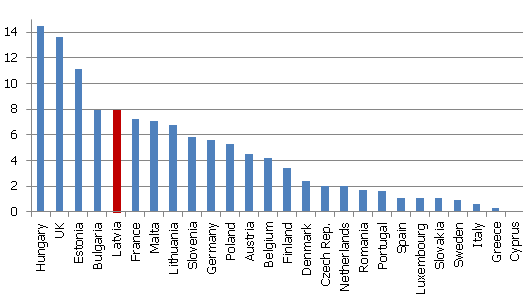
Source: European Commission data
Figure 2. Share of entrepreneurs regarding labour shortage as the main business obstacle (construction; 2013 I - IV; %; seasonally adjusted)
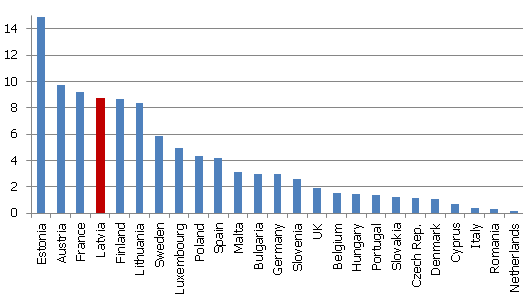
Source: European Commission data
Compared to other EU countries, 8-9% of entrepreneurs claiming labour shortage is a large number, particularly given the 14% unemployment rate. Maybe people with work experience in manufacturing and construction emigrated and there is a shortage of potential workers (while the unemployed have work experience in other sectors)? No, the situation is just the opposite. Unemployment prevalence among the people with work experience in manufacturing and construction by 35% exceeds the respective indicator for the total economy. Therefore, unemployment rate among the people with work experience in manufacturing and construction even exceeds 14%:
Figure 3. Share in the unemployed structure / share in the employed structure (2012 Q4)
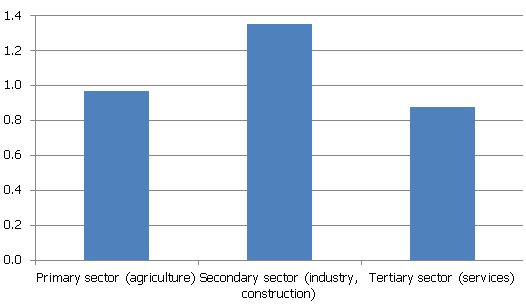
Source: Central Statistical Bureau of Latvia data, author's calculations
Therefore, the current prevalence of labour shortage in Latvia at the time of 14% unemployment may imply a high level of structural unemployment. Is high structural unemployment a consequence of the recent crisis? No, both the prevalence of labour shortage and unemployment nowadays is just the same as it was in 1998. And if there were no structural changes that changed the relation between unemployment and labour shortage, there is no evidence of the major change of structural unemployment level either:
Figure 4. Labour shortage in manufacturing and unemployment rate 1998 – 2012 (%)
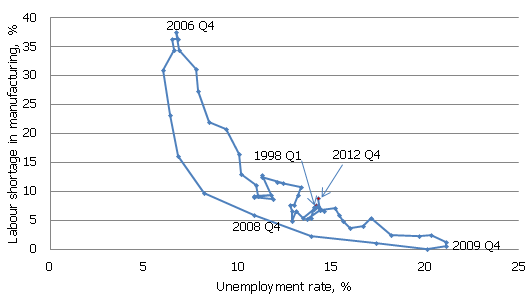
Source: Eurostat and European Commission data
2. How many vacancies are there in Latvia?
At the end of 2012, there were just 25 vacancies in construction. In hotels and restaurants, however, there were no free workplaces available at all. And it is not a joke, but official CSB data which are copy-pasted to Eurostat and then used for international comparisons. Even CV-online database (which, of course, is far from complete) shows that in some sectors the number of vacancies is bigger than Eurostat suggests. Furthermore, the total number of vacancies in the State Employment Agency database (which is again far from complete and is known for its bias in favor of low-skilled vacancies) exceeds the number of vacancies published by Eurostat (which is then believed to fully represent total economy?).
Why the CSB - Eurostat data do not include all vacancies in Latvia – is it either due to the large prevalence of the shadow economy or the statistical methodology impact, or some other factors? And is the number of "shadow" vacancies in Latvia bigger than in other countries?
Keeping in mind that the true number of vacancies in Latvia is indeed higher than the official number, let's see whether the official number of vacancies in Latvia is really so "extremely low" as it seems to be in Mihails Hazan's presentation.
Beveridge curve suggests that the higher the unemployment, the smaller the vacancy rate, and vice versa. The total (official) number of vacancies in Latvia (compared to other European countries) is broadly consistent with the unemployment rate:
Figure 5. Vacancy rate (total economy) and unemployment
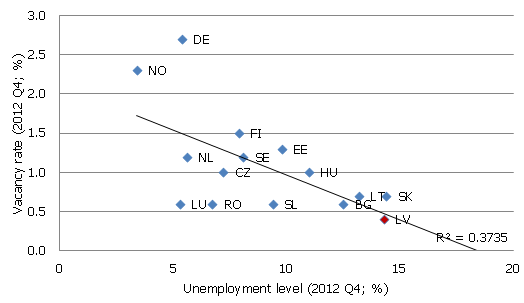
Source: Eurostat data
Even manufacturing, being under special attention owing to its relatively low level of vacancies, is not an outlier:
Figure 6. Vacancy rate (manufacturing) and unemployment
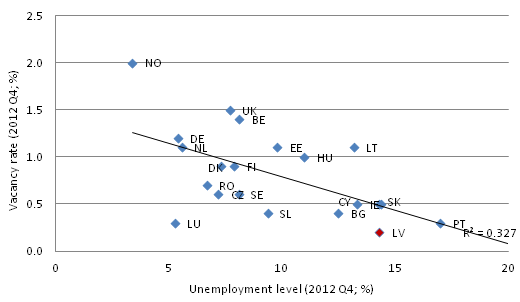
Source: Eurostat data
Similarly, also in other sectors where the official number of vacancies in Latvia is larger, it is broadly consistent with Latvia's unemployment rate and the experience of other European countries:
Figure 7. Vacancy rate (information and communication) and unemployment
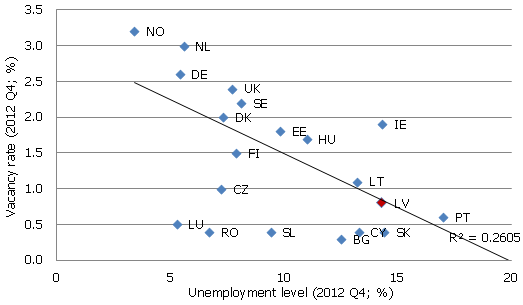
Source: Eurostat data
Then Mihails Hazans presented an argument that the vacancy rate was "extremely low" compared to Latvia's historical data. However, this argument is disposed even by Vanags et.al. paper: Beveridge curve (page 20) shows that the current level of vacancies (given the unemployment level) is similar to that in 2005.
Vacancy rate in Latvia is neither too high nor too low. It is just as it could be expected, given the 14% unemployment rate. It is by no means "extremely low", particularly keeping in mind that the true number of vacancies certainly exceeds the official number.
3. How fast are vacancies filled?
Mihails Hazans calculated that the mean vacancy duration in Latvia was about 20 days. He regarded vacancy duration to be too fast to be consistent with the high structural unemployment story. However, how can we be sure that 20 days is really fast? Mihails Hazans compared 20 days with:
1) Average unemployment duration, which is longer.
But unemployment duration always and everywhere exceeds vacancy duration (and it is a normal situation). It could be similar to comparing the number of vacancies with that of the unemployed, and then concluding: as the number of the unemployed is larger (and it is larger always and everywhere – even in Latvia in 2007) than the number of jobs is not sufficient and structural unemployment is not the case.
2) Mean vacancy duration in 2008, which was longer.
But the reason for that is straightforward: unemployment rate in 2012 was higher than 4 years ago. The higher the unemployment, the smaller vacancy duration could be expected. This is confirmed also by Mihails Hazans' calculations:
Figure 8. Mean vacancy duration and unemployment

Source: Eurostat data, Mihails Hazans calculations (slide 14)
In my view, to clarify whether the mean vacancy duration of 20 days should be regarded as short or long, it should be compared with the mean vacancy duration in other countries with similar unemployment. As I know, the respective statistics is not available, but, possibly, Mihails Hazans has more information on that.
Conclusion
Up to now, there is no strong argument why Latvia's structural unemployment nowadays should be regarded as low. It seems like structural unemployment was consistently high during the last two decades. Vanags et.al. proved that structural unemployment remained virtually unchanged since the start of the recession. Had they used data available since 1990-ies, a similar conclusion could be attributed to the last 15 years as well (and that would confute their conclusion about low structural unemployment in Latvia nowadays).
Also, the arguments of Mihails Hazans are not convincing. First, the prevalence of labour shortage should be compared not only with the degree of insufficient demand, but also with the prevalence of labour shortage in other countries. Second, when comparing vacancy rate by country, unemployment differences should be taken into account. Third, the mean vacancy duration should be compared with that in other countries with similarly high unemployment rather than with the mean unemployment duration.
Textual error
«… …»


